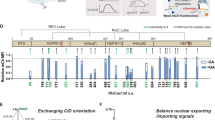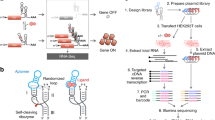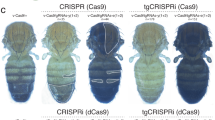Abstract
Over the last years, RNA interference (RNAi) has become a widely used technique that permits the knock-down, and hence functional analysis, of individual genes in vertebrate cells. However, the high failure rate of the RNA molecules used in RNAi experiments continues to be a problem. In this paper, I describe a set of design criteria, experimental steps and expression vectors that can facilitate the effective knock-down of almost any vertebrate gene product in cultured cells or in experimental animals.
This is a preview of subscription content, access via your institution
Access options
Subscribe to this journal
Receive 12 print issues and online access
$259.00 per year
only $21.58 per issue
Buy this article
- Purchase on Springer Link
- Instant access to full article PDF
Prices may be subject to local taxes which are calculated during checkout



Similar content being viewed by others
References
Tomari Y, Zamore PD . Perspective: machines for RNAi. Genes Dev 2005; 19: 517–529.
Paddison PJ, Caudy AA, Bernstein E, Hannon GJ, Conklin DS . Short hairpin RNAs (shRNAs) induce sequence-specific silencing in mammalian cells. Genes Dev 2002; 16: 948–958.
Brummelkamp TR, Bernards R, Agami R . A system for stable expression of short interfering RNAs in mammalian cells. Science 2002; 296: 550–553.
Bernstein E, Caudy AA, Hammond SM, Hannon GJ . Role for a bidentate ribonuclease in the initiation step of RNA interference. Nature 2001; 409: 295–296.
Zhang H, Kolb FA, Brondani V, Billy E, Filipowicz W . Human Dicer preferentially cleaves dsRNAs at their termini without a requirement for ATP. EMBO J 2002; 21: 5875–5885.
Elbashir SM, Harborth J, Lendeckel W, Yalcin A, Weber K, Tuschl T . Duplexes of 21-nucleotide RNAs mediate RNA interference in cultured mammalian cells. Nature 2001; 411: 494–498.
Hammond SM, Bernstein E, Beach D, Hannon GJ . An RNA-directed nuclease mediates post-transcriptional gene silencing in Drosophila cells. Nature 2000; 404: 293–295.
Schwarz DS, Hutvágner G, Haley B, Zamore PD . Evidence that siRNAs function as guides, not primers, in the Drosophila and human RNAi pathways. Mol Cell 2002; 10: 537–548.
Martinez J, Patkaniowska A, Urlaub H, Lührmann R, Tuschl T . Single-stranded antisense siRNAs guide target RNA cleavage in RNAi. Cell 2002; 110: 563–574.
Liu J, Carmell MA, Rivas FV, Marsden CG, Thomson JM, Song JJ et al. Argonaute2 is the catalytic engine of mammalian RNAi. Science 2004; 305: 1437–1441.
Meister G, Landthaler M, Patkaniowska A, Dorsett Y, Teng G, Tuschl T . Human Argonaute2 mediates RNA cleavage targeted by miRNAs and siRNAs. Mol Cell 2004; 15: 185–197.
Doench JG, Petersen CP, Sharp PA . siRNAs can function as miRNAs. Genes Dev 2003; 17: 438–442.
Zeng Y, Yi R, Cullen BR . MicroRNAs and small interfering RNAs can inhibit mRNA expression by similar mechanisms. Proc Natl Acad Sci USA 2003; 100: 9779–9784.
Hutvágner G, Zamore PD . A microRNA in a multiple-turnover RNAi enzyme complex. Science 2002; 297: 2056–2060.
Lagos-Quintana M, Rauhut R, Lendeckel W, Tuschl T . Identification of novel genes coding for small expressed RNAs. Science 2001; 294: 853–858.
Cai X, Hagedorn CH, Cullen BR . Human microRNAs are processed from capped, polyadenylated transcripts that can also function as mRNAs. RNA 2004; 10: 1957–1966.
Lee Y, Kim M, Han J, Yeom KH, Lee S, Baek SH et al. MicroRNA genes are transcribed by RNA polymerase II. EMBO J 2004; 23: 4051–4060.
Lee Y, Ahn C, Han J, Choi H, Kim J, Yim J et al. The nuclear RNase III Drosha initiates microRNA processing. Nature 2003; 425: 415–419.
Han J, Lee Y, Yeom KH, Kim YK, Jin H, Kim VN . The Drosha–DGCR8 complex in primary microRNA processing. Genes Dev 2004; 18: 3016–3027.
Gregory RI, Yan KP, Amuthan G, Chendrimada T, Doratotaj B, Cooch N et al. The microprocessor complex mediates the genesis of microRNAs. Nature 2004; 432: 235–240.
Denli AM, Tops BB, Plasterk RH, Ketting RF, Hannon GJ . Processing of primary microRNAs by the microprocessor complex. Nature 2004; 432: 231–235.
Lund E, Guttinger S, Calado A, Dahlberg JE, Kutay U . Nuclear export of microRNA precursors. Science 2004; 303: 95–98.
Yi R, Qin Y, Macara IG, Cullen BR . Exportin-5 mediates the nuclear export of pre-microRNAs and short hairpin RNAs. Genes Dev 2003; 17: 3011–3016.
Zeng Y, Yi R, Cullen BR . Recognition and cleavage of primary microRNA precursors by the nuclear processing enzyme Drosha. EMBO J 2005; 24: 138–148.
Khvorova A, Reynolds A, Jayasena SD . Functional siRNAs and miRNAs exhibit strand bias. Cell 2003; 115: 209–216.
Schwarz DS, Hutvagner G, Du T, Xu Z, Aronin N, Zamore PD . Asymmetry in the assembly of the RNAi enzyme complex. Cell 2003; 115: 199–208.
Bridge AJ, Pebernard S, Ducraux A, Nicoulaz AL, Iggo R . Induction of an interferon response by RNAi vectors in mammalian cells. Nat Genet 2003; 34: 263–264.
Zeng Y, Wagner EJ, Cullen BR . Both natural and designed micro RNAs can inhibit the expression of cognate mRNAs when expressed in human cells. Mol Cell 2002; 9: 1327–1333.
Boden D, Pusch O, Silbermann R, Lee F, Tucker L, Ramratnam B . Enhanced gene silencing of HIV-1 specific siRNA using microRNA designed hairpins. Nucleic Acid Res 2004; 32: 1154–1158.
Zeng Y, Cullen BR . Structural requirements for pre-microRNA binding and nuclear export by Exportin 5. Nucleic Acid Res 2004; 32: 4776–4785.
Manche L, Green SR, Schmedt C, Matthews MB . Interactions between double-stranded RNA regulators and the protein kinase. Mol Cell Biol 1992; 12: 5238–5248.
Reynolds A, Leake D, Boese Q, Scaringe S, Marshall WS, Khvorova A . Rational siRNA design for RNA interference. Nat Biotech 2004; 22: 326–330.
Overhoff M, Alken M, Far RK, Lemaitre M, Lebleu B, Sczakiel G et al. Local RNA target structure influences siRNA efficacy: a systematic global analysis. J Mol Biol 2005; 348: 871–881.
Brown KM, Chu C, Rana TM . Target accessibility dictates the potency of human RISC. Nat Struct Mol Biol 2005; 12: 469–470.
Westerhout EM, Ooms M, Vink M, Das AT, Berkhout B . HIV-1 can escape from RNA interference by evolving an alternative structure in its RNA genome. Nucleic Acid Res 2005; 33: 796–804.
Ding Y, Lawrence CE . A statistical sampling algorithm for RNA secondary structure prediction. Nucleic Acid Res 2003; 31: 7280–7301.
Ding Y, Chan CY, Lawrence CE . Sfold web server for statistical folding and rational design of nucleic acids. Nucleic Acid Res 2004; 32: W135–W141.
Zeng Y, Cullen BR . RNA interference in human cells is restricted to the cytoplasm. RNA 2002; 8: 855–860.
Robb GB, Brown KM, Khurana J, Rana TM . Specific and potent RNAi in the nucleus of human cells. Nat Struct Mol Biol 2005; 12: 133–137.
Barton GM, Medzhitov R . Retroviral delivery of small interfering RNA into primary cells. Proc Natl Acad Sci USA 2002; 99: 14943–14945.
Brummelkamp TR, Bernards R, Agami R . Stable suppression of tumorigenicity by virus-mediated RNA interference. Cancer Cell 2002; 2: 243–247.
Lee M-TM, Coburn GA, McClure MO, Cullen BR . Inhibition of human immunodeficiency virus type 1 replication in primary macrophages by using Tat- or CCR5-specific small interfering RNAs expressed from a lentivirus vector. J Virol 2003; 77: 11964–11972.
Rubinson DA, Dillon CP, Kwiatkowski AV, Sievers C, Yang L, Kopinja J et al. A lentivirus-based system to functionally silence genes in primary mammalian cells, stem cells and transgenic mice by RNA interference. Nat Genet 2003; 33: 401–406.
Tiscornia G, Singer O, Ikawa M, Verma IM . A general method for gene knockdown in mice by using lentiviral vectors expressing small interfereing RNA. Proc Natl Acad Sci USA 2003; 100: 1844–1848.
Whither RNAi? Nat Cell Biol 2003; 5: 489–490.
Acknowledgements
I thank Dr Alexandra Schäfer for assistance with the figures used in this manuscript. This work was supported by Grant GM071408 from the National Institutes of Health.
Author information
Authors and Affiliations
Corresponding author
Rights and permissions
About this article
Cite this article
Cullen, B. Induction of stable RNA interference in mammalian cells. Gene Ther 13, 503–508 (2006). https://doi.org/10.1038/sj.gt.3302656
Received:
Revised:
Accepted:
Published:
Issue Date:
DOI: https://doi.org/10.1038/sj.gt.3302656
Keywords
This article is cited by
-
Regulatory elements in vectors containing the ctEF-1α first intron and double enhancers for an efficient recombinant protein expression system
Scientific Reports (2018)
-
Adenovirus vectors lacking virus-associated RNA expression enhance shRNA activity to suppress hepatitis C virus replication
Scientific Reports (2013)
-
RNAi: a potential new class of therapeutic for human genetic disease
Human Genetics (2011)
-
Prevention of interferon-stimulated gene expression using microRNA-designed hairpins
Gene Therapy (2009)
-
Non-protein coding RNA biomarkers and differential expression in cancers: a review
Journal of Experimental & Clinical Cancer Research (2008)



